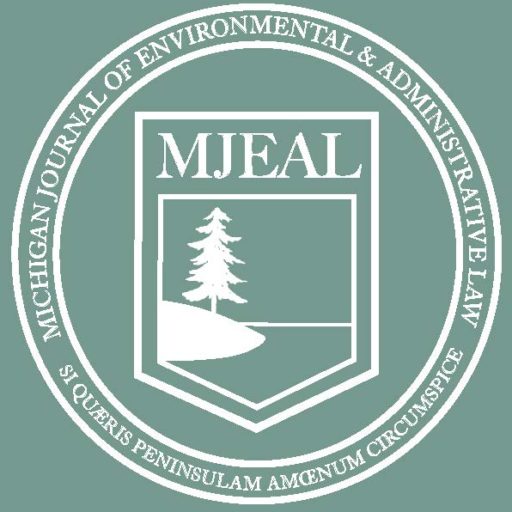Rushing Repeal: Why the ‘Good Cause’ Shortcut Could Backfire on Agencies and the Environment Maya Granderson From his first term in office, President Donald Trump has made it his mission to rid American industries of “the never-ending growth of red tape.”[1] His quest began with Executive Order 13771, which stated that “for every one new… Continue reading Granderson – Fall 2025
Author: mjeal-online
Tahara – Fall 2025
EPA vs. Industry: Showdown Over PFAS Kevin Tahara PFAS (Per- and Polyfluoroalkyl substances) are a new frontier in environmental and regulatory law that will test the EPA’s administrative procedures. PFAS are manufactured chemicals that have been widely used since the 1940s in industrial and consumer products[1]. Nicknamed “forever chemicals,”[2] PFAS are known for their longevity… Continue reading Tahara – Fall 2025
Hipps – Fall 2025
A Recent Sixth Circuit Dormant Commerce Ruling and Michigan’s Hybrid Electricity Market Claire Hipps Do you want cheaper, cleaner energy? Do you want to minimize blackouts and brownouts? Michigan’s energy is relatively unclean and high-priced, and its reliability metrics are abysmal.[1] Increased competition could lead to lower consumer pricing and reduce the market power of… Continue reading Hipps – Fall 2025
Nguyen – Fall 2025
Red Tides in Florida: Current Legislation and Litigation Efforts Anna Nguyen “Red tides,” also known as harmful algae blooms (HABs), have devastating impacts on the environment.[1] These blooms occur when algae grows out of control, producing toxic effects on the ecosystem and humans and often turning the water red.[2] Human activity has increased the frequency… Continue reading Nguyen – Fall 2025
Herenda – Fall 2025
Synthetic Fuel Development in Chile: Evaluating the Regulatory Environmental Framework Aila Herenda Chile is poised to become one of the world’s leading countries in synthetic fuel production and development. Punta Areas, one of Chilean Patagonia’s southernmost cities, has proven to be a successful landscape for the installment of wind turbines, allowing for creation of the… Continue reading Herenda – Fall 2025
Hopkins – Fall 2025
Un-Permitted Rescission? Permitting Rules & Reliance Interests Coleman Hopkins In its first year, the second Trump Administration has moved aggressively to reshape the federal government, upending Executive Branch norms[1] and expectations[2] that once seemed secure. Green energy programs — long disfavored by President Trump[3] — have been a particular target, with the administration moving to… Continue reading Hopkins – Fall 2025
Kim – Winter 2025
The Statutory Interpretation of Tug-of-war: Chevron No Longer Ryan Kim “Chevron is overruled.”[1] Chief Justice Robert’s three words echo a new era of uncertainty into the domain of statutory interpretation. Some raise concerns about the dismantling of the federal agencies’ role in administering Congress’ laws, some criticize the action as a judicial power grab, and… Continue reading Kim – Winter 2025
Messe – Winter 2025
U of M’s Progress on Sustainability Initiatives Josh Messe The University of Michigan hails its Campus Plan 2050 as “a blueprint for our future.”1 The plan was first announced in late 2023, with detailed plans released in late 2024. The 25-year plan focuses on long-term investments to modernize academic facilities and transportation options on campus… Continue reading Messe – Winter 2025
Baer – Winter 2025
More Carrots, Less Sticks – Increasing Tax Compliance Through Greater Taxpayer Discretion Jessica Baer As the calendar approaches April 15th, millions of Americans prepare to file income tax returns; and each year, Americans short the Internal Revenue Service (IRS) over half a trillion dollars.1 Most proposals aimed at increasing compliance seek to leverage punishments or… Continue reading Baer – Winter 2025
Coty – Winter 2025
A Positive Spin on the End of Chevron? Ainsley Coty In late June of 2024, the Supreme Court overturned a decades-long precedent, “Chevron Deference,” in Loper Bright v. Raimondo.1 Chevron Deference required courts to give deference to administrative agencies’ statutory interpretation.2 Now, courts have more power to interpret statutes for themselves, potentially limiting administrative agencies’… Continue reading Coty – Winter 2025
